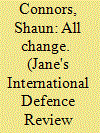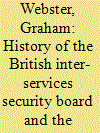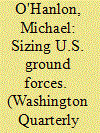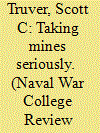| Srl | Item |
| 1 |
ID:
133979


|
|
|
|
|
| Publication |
2014.
|
| Summary/Abstract |
The UK Ministry of Defence's (MoD's) Multi Role Vehicles - Protected (MRV-P) programme is intended to replace around 50% of the current soft-skin Land Rover and Pinzgauer light vehicle fleet with a capability better suited to projected future operational requirements, and a senior defence official has set out from details for the first time.
|
|
|
|
|
|
|
|
|
|
|
|
|
|
|
|
| 2 |
ID:
133419


|
|
|
|
|
| Publication |
2014.
|
| Summary/Abstract |
During the Second World War there was an increasingly developed system for controlling the code-names used for operations where different Allied forces were involved. This paper follows the development of this system - based on the British Inter-Services Security Board - that spread to overseas theatres on the British side and to American forces world-wide. The selection of code-names was not without controversy; with Winston Churchill getting personally involved and his intervention is highlighted. A critique of the system is attempted, although the final judge is ultimately the success of the security of the activities disguised by the code-names.
|
|
|
|
|
|
|
|
|
|
|
|
|
|
|
|
| 3 |
ID:
133782


|
|
|
|
|
| Publication |
2014.
|
| Summary/Abstract |
During the Cold War, the United States varied between a "1 ½ war" and a "2 ½ war" framework for sizing its main combat forces. This framework prepared forces for one or two large wars, and then a smaller "half-war." Capacity for a major conflict in Europe, against the Soviet Union and its Warsaw Pact allies, represented the enduring big war potential. This period saw simultaneous conflict against China as a second possible big war, until Nixon's Guam doctrine placed a greater burden on regional allies rather than U.S. forces to address such a specter, and until his subsequent opening to the PRC made such a war seem less likely in any event. The half-wars were seen as relatively more modest but still quite significant operations such as in Korea or Vietnam.
|
|
|
|
|
|
|
|
|
|
|
|
|
|
|
|
| 4 |
ID:
133409


|
|
|
|
|
| Publication |
2012.
|
| Summary/Abstract |
A mine is a terrible thing that waits. The easy way is always mined. Any ship can be a minesweeper-once. Sea mines and the need to counter them have been constants for the U.S. Navy since the earliest days of the Republic. In January 1778, patriot David Bushnell used floating kegs of gunpowder fitted with contact firing mechanisms to attack a British fleet anchored in the Delaware River above Philadelphia. Four British sailors died trying to retrieve the kegs-an early example of the challenges of explosive ordnance disposal (EOD) against an unknown threat-but the ships were unscathed. Since that uncertain beginning, mines and mine countermeasures (MCM) have figured prominently in the Civil War, Spanish-American War, both world wars, Korea, Vietnam, numerous Cold War crises, and Operations DESERT STORM and IRAQI FREEDOM.
|
|
|
|
|
|
|
|
|
|
|
|
|
|
|
|